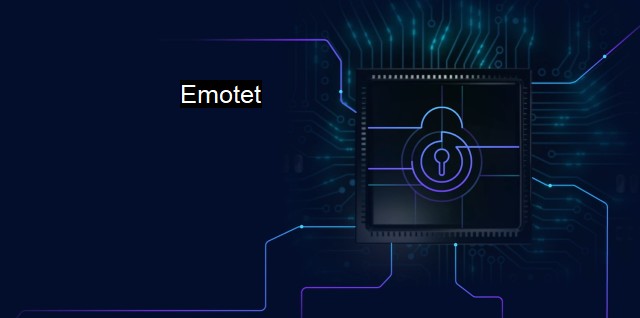What is Emotet?
The Emergence of Emotet: A Threat to Cybersecurity in the Digital Age
Emotet is a type of malicious software, or malware, that has been creating havoc in the cyber world ever since its discovery in 2014. This sophisticated Trojan was initially designed as a banking malware to steal sensitive data. over time, its architecture and modus of operation have evolved. Emotet now serves as a virus that can launch a variety of threats, thereby making it one of the most potent threats to individual and organizational cybersecurity around the globe.Interestingly, Emotet does not conduct malevolent activities by itself. Instead, it acts like a 'carrier' for other types of malware, providing an entry point into the target's network or device. Once it has established a solid foothold, it communicates back to its command and control servers (C&C Servers) and downloads various types of malware under instructions from hackers operating these servers. These subsidiary threats could range from crypto miners to destructive ransomware that encrypts data and demands a ransom for its release.
The modus operandi of Emotet predominantly includes a technique known as spear-phishing email. It capitalizes on people's gullibility and actions towards seemingly harmless emails. These emails come embedded with malicious URLs or malware-laden documents crafted in such a way that they invoke curiosity or urgency in the recipient. When the recipient clicks on the URL or opens the document, Emotet gets released into their computer system.
The potency of Emotet lies predominantly in its ability to self-propagate swiftly. After infecting one device, it leverages the built-in Windows network commands to reproduce and spread to all reachable computers on the same network. This polymorphic behavior, coupled with Emotet's ability to remain undetectable by changing its identifiable features regularly, makes it challenging to ward off.
Unlike traditional malware, Emotet has the fascinating and frightening ability to evolve. Trends in cybersecurity have indicated that cybercriminals use it creatively to maximize the damage in the chosen targets. Sometimes, Emotet would lay dormant for an extended period before launching a devastating attack.
Initially, Emotet's primary target was individuals. Still, over time, it has shifted its focus predominantly towards institutions and businesses. This shift can be attributed to the high-value data organizations possess, providing a lucrative opportunity for hackers aiming to sell data or hold it for ransom.
Emotet's threat also originates from its ability to compromise contacts. Once Dyre has infiltrated one device in a network, it recognizes email contacts and users, and uses the ‘snowshoe’ spam method. This method involves sending malicious emails to contacts who see a familiar sender and thus, are more likely to open the email, further spreading the malware throughout an organization.
Mitigating Emotet requires a multi-layered approach. Utilizing a strong and advanced security solution i.e., a reliable antivirus that can detect Emotet-like behavior is elemental. A holistic cybersecurity approach should involve firewalls to block known malicious IP addresses, email gateway solutions to screen and filter spear-phishing emails, and intrusion detection and prevention systems.
Cybersecurity education and user awareness are also critical in countering Emotet and other such sophisticated cyber threats. Since malicious actors primarily target human weaknesses, erudition about best practices regarding scrutinizing email attachments, verifying sender details, refraining from downloading unverified software can go a long way in fortifying cybersecurity.
An integral defensive strategy against Emotet includes regular backup and timely patching of applications and software to ensure that viruses do not exploit loopholes and weaknesses. Periodic scans to unearth possible hidden threats and expeditious isolation coupled with rectification in case of detection are highly recommended.
Recovery and response plans, especially ranking protocols for threat detection, should be in place. Malicious actors frequently adjust and fine-tune their malware; thus, it's equally crucial to be flexible and adjust one's defensive strategies frequently. Undeniably, Emotet brings in this need for dynamic vigilance and proactive counterattack preparation in cybersecurity against malware evolution.

Emotet FAQs
What is Emotet?
Emotet is a type of malware that is designed to steal sensitive information from infected computers. It is often used to distribute other types of malware, such as ransomware, to other computers on a network.How does Emotet infect computers?
Emotet is typically spread through phishing emails that contain malicious attachments or links. Once a user clicks on the attachment or link, Emotet is downloaded onto the computer and can start infecting the system.What can I do to protect my computer from Emotet?
To protect your computer from Emotet, it is important to have up-to-date antivirus software installed and to regularly update your operating system and other software. You should also be cautious when opening emails or clicking on links, especially if they are from unknown senders.What should I do if my computer is infected with Emotet?
If your computer is infected with Emotet, you should immediately disconnect it from any networks and contact a cybersecurity professional. They can help you remove the malware and ensure that your data is secure.| | A | | | B | | | C | | | D | | | E | | | F | | | G | | | H | | | I | | | J | | | K | | | L | | | M | |
| | N | | | O | | | P | | | Q | | | R | | | S | | | T | | | U | | | V | | | W | | | X | | | Y | | | Z | |
| | 1 | | | 2 | | | 3 | | | 4 | | | 7 | | | 8 | | |||||||